 Technology peripherals
Technology peripherals
 AI
AI
 Generative models build interactive real-world simulators, which LeCun thinks is pretty cool
Generative models build interactive real-world simulators, which LeCun thinks is pretty cool
Generative models build interactive real-world simulators, which LeCun thinks is pretty cool
Generative models trained on Internet data revolutionize the way text, image and video content is created. Some researchers predict that perhaps the next milestone in generative models will be the ability to simulate all aspects of human experience in the world, such as how to drive a car on the road or how to prepare meals.
Nowadays, with the help of very comprehensive real-world simulators, humans can interact with different scenes and objects, and robots can also learn from simulated experiences. This avoids the risk of physical damage.
However, one of the major obstacles to building such a real-world simulator lies in the available data sets. Although there are billions of text, images, and video clips on the Internet, different data sets cover different axes of information, and these data sets must be brought together to simulate a realistic experience of the world. For example, paired text image data contains rich scenes and objects but few actions; video subtitles and question and answer data contain rich high-level activity descriptions but few low-level motion details; human activity data contains rich human actions, But there are few mechanical movements; while robot data contains rich robot movements, but the number is limited
The information differences listed above are natural and difficult to overcome, which makes it difficult to build a system designed to capture Real-world simulators bring difficulties with real-world experiences.
In this article, researchers from UC Berkeley, Google DeepMind, MIT and other institutions explore UniSim, a universal simulator that learns real-world interactions through generative models, taking a step toward building a universal simulator. the first step. For example, UniSim can simulate how humans and agents interact with the world by simulating high-level instructions such as "open a drawer" and the visual results of low-level instructions.
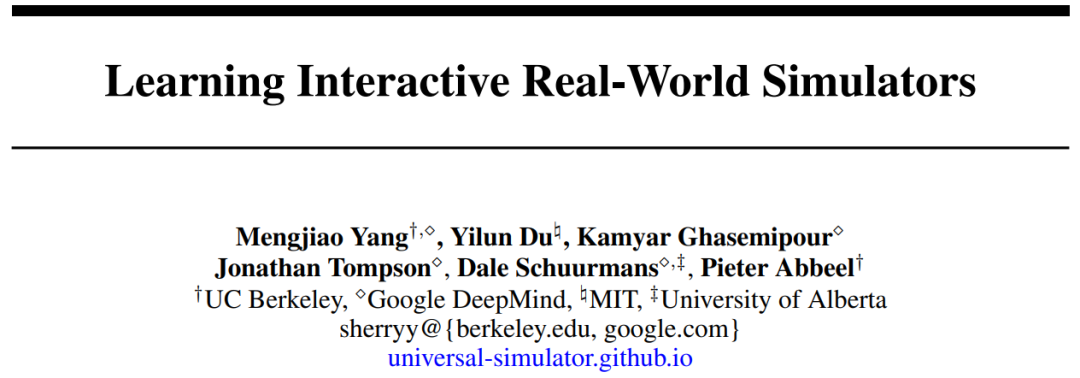
- Paper address: https://arxiv.org/pdf/2310.06114.pdf
- Paper home page: https://universal-simulator.github.io/unisim/
This paper combines large amounts of data (including Internet text-image pairs, rich data from navigation, human activities, robot actions, etc., and data from simulation and rendering) into a conditional video generation framework. Then by carefully orchestrating rich data along different axes, this paper shows that UniSim can successfully merge experience from different axes of data and generalize beyond the data to enable rich interactions through fine-grained motion control of static scenes and objects.
The following video demonstrates how UniSim simulates an example with a long interaction horizon. The video shows that UniSim simulates eight robot action instructions in one go:
UniSim’s simulation of human actions:
UniSim’s simulation deployment of RL strategy is as follows:
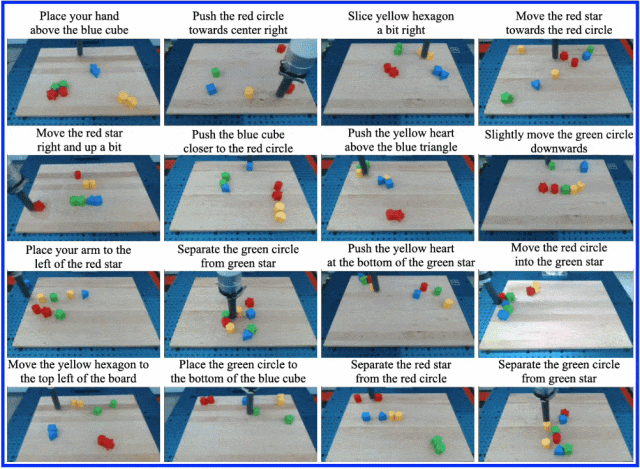
Meta Chief AI Scientist Yann LeCun and NVIDIA Senior Research Scientist Jim Fan and other industry experts forwarded this research. LeCun gave this a "cool" evaluation
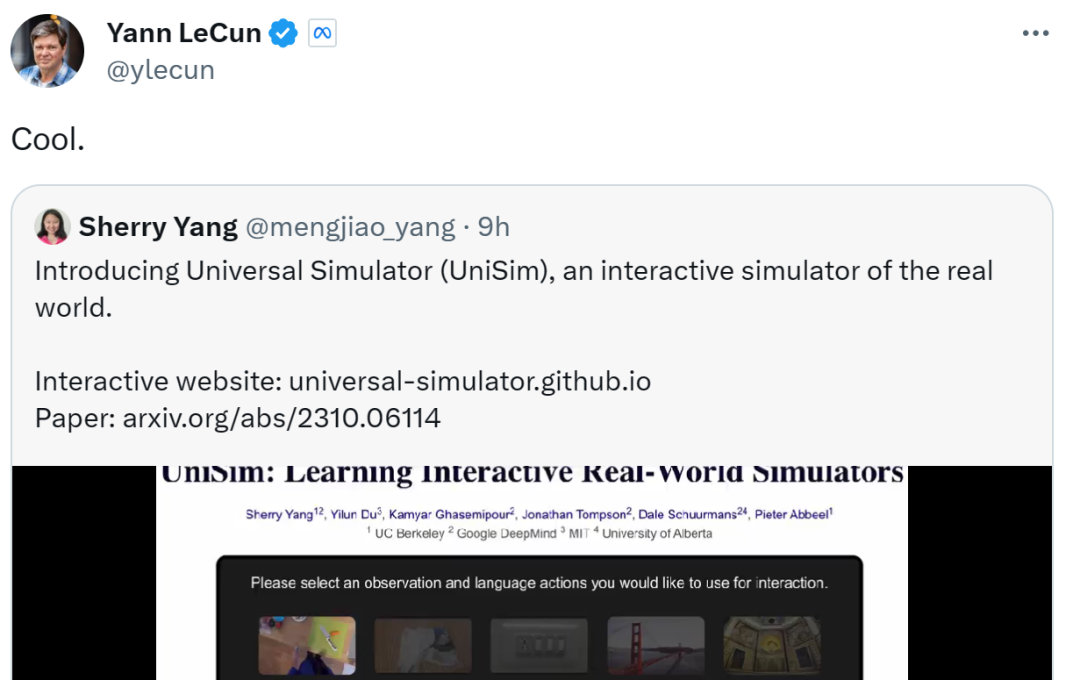
Jim Fan said that this work is very interesting. The video diffusion model is used as a data-driven physics simulation in which an agent can plan, explore, and learn optimal actions without touching the robotic hardware or causing any damage. It can be said that LLM is not only an operating system, but also a complete reality simulator
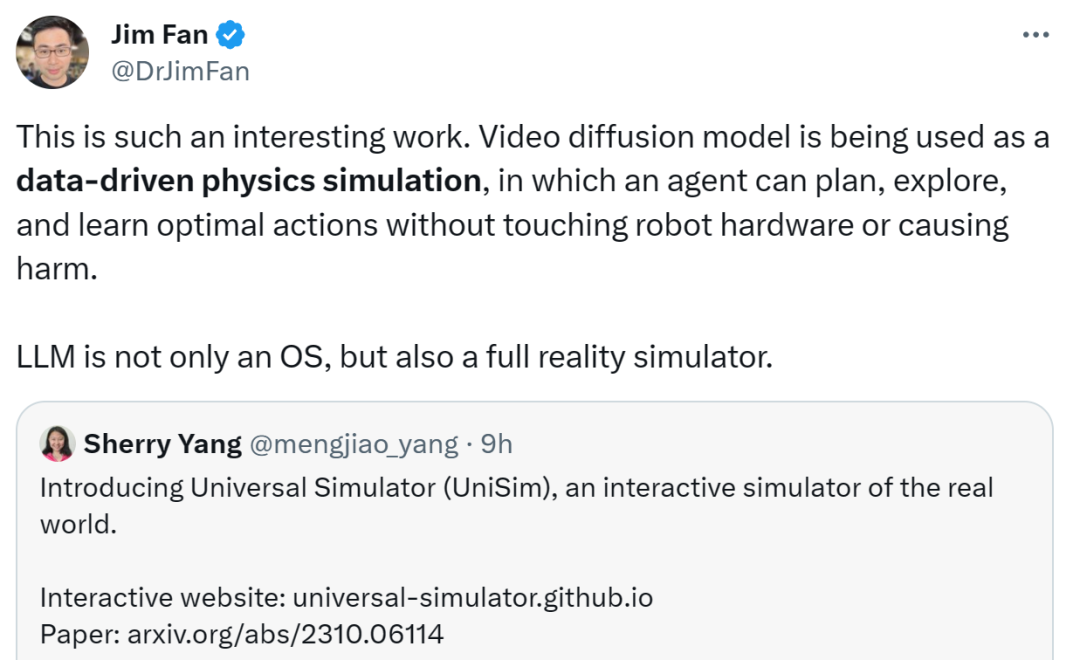
The first author of the paper is a Ph.D. from the University of California, Berkeley Student Sherry Yang said, “Learning real-world models is becoming a reality.”

Simulating real-world interactions
As shown in Figure 3, UniSim can simulate a series of rich actions in the kitchen scene, including washing hands, holding bowls, cutting carrots and Dry your hands. The top right of Figure 3 shows different switches, while the bottom of Figure 3 shows two navigation scenarios

The content that needs to be rewritten is: Correspondence The navigation scene

in the lower right corner of Figure 3 corresponds to the navigation scene
in the lower right corner of Figure 3 above. Figure 4 below shows an example of UniSim autoregressively simulating 8 interactions sequentially. In terms of long-term simulation

UniSim not only supports rich actions and Long-range interaction can also achieve highly diverse and random environmental changes. For example, after removing the top towel, the objects displayed have diversity (see Figure 5 below, left)
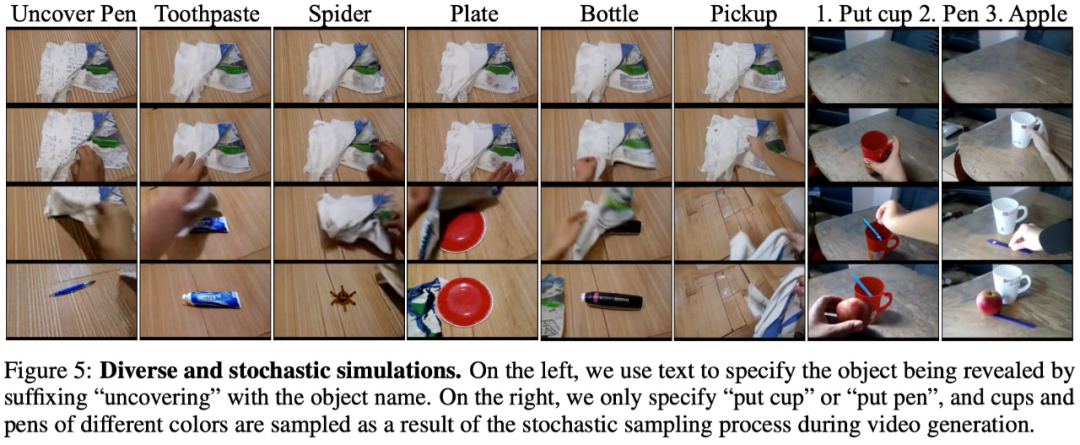
UniSim Real World Migration result. The real value of UniSim is in simulating the real world, and Figure 7 shows the language plan generated by VLM, the video generated by UniSim based on the language plan, and the execution on a real robot.
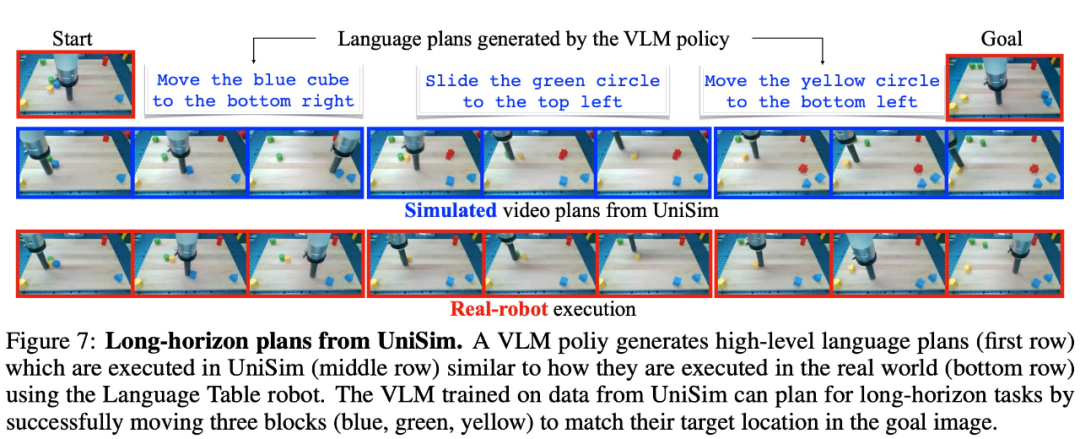
In addition to testing UniSim’s migration capabilities in the real world, this article also conducted a simulator-based evaluation. The results are shown in Table 2:
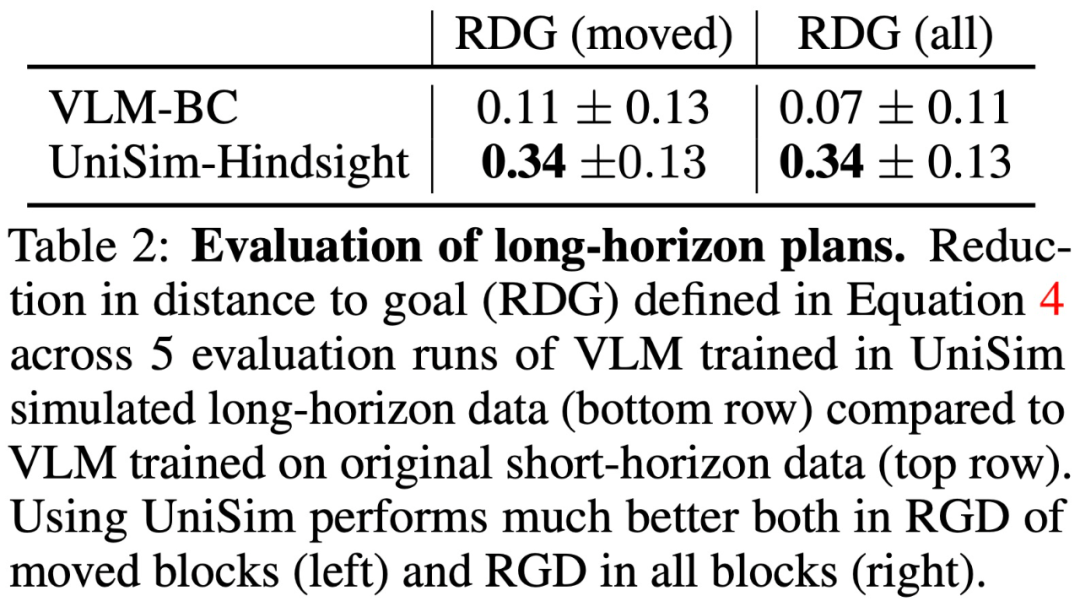
Real-world simulator for reinforcement learning
The experiment also evaluates UniSim's ability to simulate real-world How well does the robot perform various actions? The robot moves the endpoint left, right, down, and up by repeatedly performing low-level control operations for about 20-30 steps. Table 3 shows that RL training significantly improves the performance of the VLA policy in various tasks, especially in tasks such as pointing to the blue block. We then directly deploy the zero-shot RL policy trained in UniSim onto a real robot, as shown in Figure 8 (bottom row).
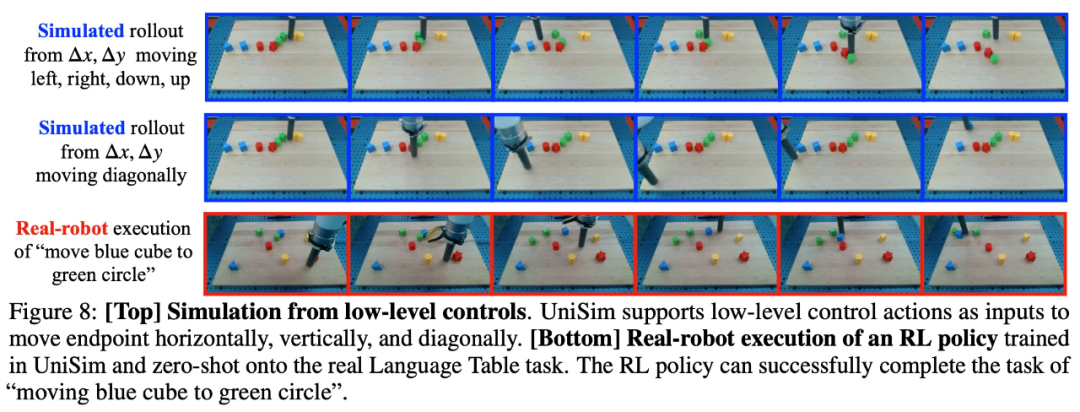
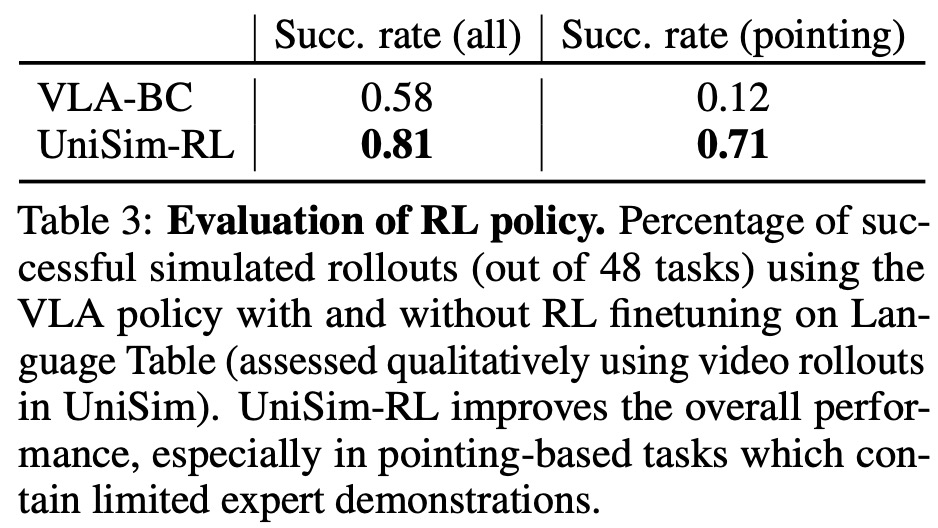
The above is the detailed content of Generative models build interactive real-world simulators, which LeCun thinks is pretty cool. For more information, please follow other related articles on the PHP Chinese website!

Hot AI Tools

Undresser.AI Undress
AI-powered app for creating realistic nude photos

AI Clothes Remover
Online AI tool for removing clothes from photos.

Undress AI Tool
Undress images for free

Clothoff.io
AI clothes remover

AI Hentai Generator
Generate AI Hentai for free.

Hot Article

Hot Tools

Notepad++7.3.1
Easy-to-use and free code editor

SublimeText3 Chinese version
Chinese version, very easy to use

Zend Studio 13.0.1
Powerful PHP integrated development environment

Dreamweaver CS6
Visual web development tools

SublimeText3 Mac version
God-level code editing software (SublimeText3)

Hot Topics
 1386
1386
 52
52
 The world's most powerful open source MoE model is here, with Chinese capabilities comparable to GPT-4, and the price is only nearly one percent of GPT-4-Turbo
May 07, 2024 pm 04:13 PM
The world's most powerful open source MoE model is here, with Chinese capabilities comparable to GPT-4, and the price is only nearly one percent of GPT-4-Turbo
May 07, 2024 pm 04:13 PM
Imagine an artificial intelligence model that not only has the ability to surpass traditional computing, but also achieves more efficient performance at a lower cost. This is not science fiction, DeepSeek-V2[1], the world’s most powerful open source MoE model is here. DeepSeek-V2 is a powerful mixture of experts (MoE) language model with the characteristics of economical training and efficient inference. It consists of 236B parameters, 21B of which are used to activate each marker. Compared with DeepSeek67B, DeepSeek-V2 has stronger performance, while saving 42.5% of training costs, reducing KV cache by 93.3%, and increasing the maximum generation throughput to 5.76 times. DeepSeek is a company exploring general artificial intelligence
 AI subverts mathematical research! Fields Medal winner and Chinese-American mathematician led 11 top-ranked papers | Liked by Terence Tao
Apr 09, 2024 am 11:52 AM
AI subverts mathematical research! Fields Medal winner and Chinese-American mathematician led 11 top-ranked papers | Liked by Terence Tao
Apr 09, 2024 am 11:52 AM
AI is indeed changing mathematics. Recently, Tao Zhexuan, who has been paying close attention to this issue, forwarded the latest issue of "Bulletin of the American Mathematical Society" (Bulletin of the American Mathematical Society). Focusing on the topic "Will machines change mathematics?", many mathematicians expressed their opinions. The whole process was full of sparks, hardcore and exciting. The author has a strong lineup, including Fields Medal winner Akshay Venkatesh, Chinese mathematician Zheng Lejun, NYU computer scientist Ernest Davis and many other well-known scholars in the industry. The world of AI has changed dramatically. You know, many of these articles were submitted a year ago.
 Google is ecstatic: JAX performance surpasses Pytorch and TensorFlow! It may become the fastest choice for GPU inference training
Apr 01, 2024 pm 07:46 PM
Google is ecstatic: JAX performance surpasses Pytorch and TensorFlow! It may become the fastest choice for GPU inference training
Apr 01, 2024 pm 07:46 PM
The performance of JAX, promoted by Google, has surpassed that of Pytorch and TensorFlow in recent benchmark tests, ranking first in 7 indicators. And the test was not done on the TPU with the best JAX performance. Although among developers, Pytorch is still more popular than Tensorflow. But in the future, perhaps more large models will be trained and run based on the JAX platform. Models Recently, the Keras team benchmarked three backends (TensorFlow, JAX, PyTorch) with the native PyTorch implementation and Keras2 with TensorFlow. First, they select a set of mainstream
 Hello, electric Atlas! Boston Dynamics robot comes back to life, 180-degree weird moves scare Musk
Apr 18, 2024 pm 07:58 PM
Hello, electric Atlas! Boston Dynamics robot comes back to life, 180-degree weird moves scare Musk
Apr 18, 2024 pm 07:58 PM
Boston Dynamics Atlas officially enters the era of electric robots! Yesterday, the hydraulic Atlas just "tearfully" withdrew from the stage of history. Today, Boston Dynamics announced that the electric Atlas is on the job. It seems that in the field of commercial humanoid robots, Boston Dynamics is determined to compete with Tesla. After the new video was released, it had already been viewed by more than one million people in just ten hours. The old people leave and new roles appear. This is a historical necessity. There is no doubt that this year is the explosive year of humanoid robots. Netizens commented: The advancement of robots has made this year's opening ceremony look like a human, and the degree of freedom is far greater than that of humans. But is this really not a horror movie? At the beginning of the video, Atlas is lying calmly on the ground, seemingly on his back. What follows is jaw-dropping
 KAN, which replaces MLP, has been extended to convolution by open source projects
Jun 01, 2024 pm 10:03 PM
KAN, which replaces MLP, has been extended to convolution by open source projects
Jun 01, 2024 pm 10:03 PM
Earlier this month, researchers from MIT and other institutions proposed a very promising alternative to MLP - KAN. KAN outperforms MLP in terms of accuracy and interpretability. And it can outperform MLP running with a larger number of parameters with a very small number of parameters. For example, the authors stated that they used KAN to reproduce DeepMind's results with a smaller network and a higher degree of automation. Specifically, DeepMind's MLP has about 300,000 parameters, while KAN only has about 200 parameters. KAN has a strong mathematical foundation like MLP. MLP is based on the universal approximation theorem, while KAN is based on the Kolmogorov-Arnold representation theorem. As shown in the figure below, KAN has
 Tesla robots work in factories, Musk: The degree of freedom of hands will reach 22 this year!
May 06, 2024 pm 04:13 PM
Tesla robots work in factories, Musk: The degree of freedom of hands will reach 22 this year!
May 06, 2024 pm 04:13 PM
The latest video of Tesla's robot Optimus is released, and it can already work in the factory. At normal speed, it sorts batteries (Tesla's 4680 batteries) like this: The official also released what it looks like at 20x speed - on a small "workstation", picking and picking and picking: This time it is released One of the highlights of the video is that Optimus completes this work in the factory, completely autonomously, without human intervention throughout the process. And from the perspective of Optimus, it can also pick up and place the crooked battery, focusing on automatic error correction: Regarding Optimus's hand, NVIDIA scientist Jim Fan gave a high evaluation: Optimus's hand is the world's five-fingered robot. One of the most dexterous. Its hands are not only tactile
 FisheyeDetNet: the first target detection algorithm based on fisheye camera
Apr 26, 2024 am 11:37 AM
FisheyeDetNet: the first target detection algorithm based on fisheye camera
Apr 26, 2024 am 11:37 AM
Target detection is a relatively mature problem in autonomous driving systems, among which pedestrian detection is one of the earliest algorithms to be deployed. Very comprehensive research has been carried out in most papers. However, distance perception using fisheye cameras for surround view is relatively less studied. Due to large radial distortion, standard bounding box representation is difficult to implement in fisheye cameras. To alleviate the above description, we explore extended bounding box, ellipse, and general polygon designs into polar/angular representations and define an instance segmentation mIOU metric to analyze these representations. The proposed model fisheyeDetNet with polygonal shape outperforms other models and simultaneously achieves 49.5% mAP on the Valeo fisheye camera dataset for autonomous driving
 The latest from Oxford University! Mickey: 2D image matching in 3D SOTA! (CVPR\'24)
Apr 23, 2024 pm 01:20 PM
The latest from Oxford University! Mickey: 2D image matching in 3D SOTA! (CVPR\'24)
Apr 23, 2024 pm 01:20 PM
Project link written in front: https://nianticlabs.github.io/mickey/ Given two pictures, the camera pose between them can be estimated by establishing the correspondence between the pictures. Typically, these correspondences are 2D to 2D, and our estimated poses are scale-indeterminate. Some applications, such as instant augmented reality anytime, anywhere, require pose estimation of scale metrics, so they rely on external depth estimators to recover scale. This paper proposes MicKey, a keypoint matching process capable of predicting metric correspondences in 3D camera space. By learning 3D coordinate matching across images, we are able to infer metric relative



